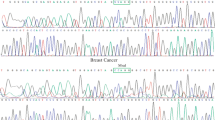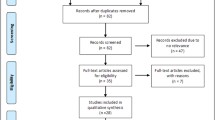Abstract
Breast cancer (BC) is one of the most common causes of death among women, and second in Iran. The objectives of this study were to determine the frequency of RAD51 G/C polymorphism in patients with breast cancer. We evaluated these polymorphisms and effects on the breast cancer risk association in a Iranian sporadic population-based case–control study of 294 breast cancer cases and 315 controls using a PCR–RFLP-based assay. Analyses of affected and controls show that homozygote genotype RAD51 GG has the highest frequency in both groups (33.3 in patients and 41.4 in control group). Genotype RAD51 GG most risk factor were in our population: [CC/GC odds ratio, 0.364 (95 % confidence interval; CI, 0.168–0.788) p = 0.009, CC/GG odds ratio, 0.828 (95 % CI, 0.411–1.668) p = 0.596], GG/GC odds ratio, 2.276 (95 % CI, 1.497–3.460) p = 0.001]. There was a significant association of breast cancer risk with RAD51 GG and CC polymorphism.
Similar content being viewed by others
Avoid common mistakes on your manuscript.
Introduction
Breast cancer is an increasingly important cause of illness and death among women.
Study of RAD51 gene in breast cancer are two reasons; the involvement of RAD51 in the stability of the genome and, potential to modify the penetrance of BRCA1/BRCA2 mutations, which can increase susceptibility for breast cancer.
A single nucleotide polymorphism in the 5-untranslated region (5′UTR) of RAD51 (a G to C substitution at position 135, the G/C polymorphism) can influence breast cancer risk [1, 2].
The RAD51 gene makes a protein also called RAD51, which is essential for the repair of damaged DNA.
We reported here the allele frequencies of RAD51 GG and CC significant in breast cancer patients in Iran.
Materials and methods
A) Patients data:
Analyses were conducted for the 294 patients and 315 controls genotyped for RAD51 and ages were 35–55 years.
This study ethically was approved by the local Ethical Committee of Islamic Azad University from the point of view of patients’ and also control group samples rights.
All patients participated in the Special Medical Centre, part of chemotherapy, Tehran, Iran. A questionnaire including questions on breast cancer risk factors were completed and each patient filled a consent form. The blood samples were collected from patients and controls prior to start of treatment. Subjects were genotyped for the RAD51 SNP using genomic DNA Extracted from peripheral blood lymphocytes. DNA was isolated from peripheral blood using FelxiGene DNA extraction kit (Qiagen Germany).
B) Genotyping.
The polymorphisms were detected using a modified PCR–RFLP method [3, 4]. The PCR primers were synthesized by TAG Copenhagen A/S Primers were for each polymorphism is as follows.
A1298C polymorphism, (175 bp), Forward: 5′ TGG GAA CTG CAA CTC ATC TGG 3′, Reverse: 5′ GCG CTC CTC TCT CCA GCAG 3′.
The cycling conditions were 94 °C, 30 s; 58 °C, 30 s; 72 °C, 60 s (35 cycle). The PCR products were digested with 1 unit of MvaI and separated on a 6 % acrylamid gel.
This method is able to detect all three possible genotypes for the polymorphism: homozygous wild type, heterozygous variant type and homozygous variant type.
The genotypes and allelic frequencies of RAD51 polymorphisms in Patient and control groups were analyses by χ2 and Fisher’s exact tests.
Results
The aim of the present study was to attempt to elucidate a role for RAD51 as a high-risk breast cancer using of PCR–RFLP metod.
There was a significant between RAD51 polymorphism and breast cancer risk.
Analyses of affected and controls show that heterozygote genotype RAD51 GC has the highest frequency in both groups (12.6 in patients and 6.9 in control group) (Fig. 1).
On the other hands, The homozygote genotype in RAD51 GG has an increase in Frequency in case and control group compared with another genotype (33.3 in patients and and 41.4 in control group) (Table 1; Fig. 2).
Genotype RAD51 GC was most important risk factor in our population; After Genotype RAD51 GC, Genotype CC was most risk factor in our population.
Comparison between genotypes, odds ratio and p value: Showed that p value of Our results showed that the Genotype RAD51 GC most risk factor were in our population: [GC odds ratio, 2.276 (95 % CI, 1.497–3.460) p = 0.001***, CC odds ratio, 0.364, (95 % confidence interval; CI, 0.168–0.788) p = 0.009, GG odds ratio, 0.828, (95 % CI, 0.411–1.668) p = 0.596]. Table 2
In our study were significant analyze between RAD51 polymorphism in relation to breast cancer risk.
So, We conclude that not only has a high frequency of GG in control and case group in Iranian women, but also there is a relation between presences of RAD51 GC and increasing of breast cancer.
Discussion
The mechanisms of cancer risk modification by RAD51 are unknown.
On the other hands, the interactions of RAD51 with effects in breast tumourigenesis can be evidence to a role for RAD51 in breast cancer Risk. The RAD51 gene is located at chromosome position 15q15.1 [5], a region shown to exhibit loss of heterozygosity in a most range of cancers, including those of the lung, the colorectum and the breast [6].
It seems may that, binds to BRCA1, and involved in repair of double-strand DNA breaks [7]. These findings suggest that loss of RAD51 function may indused to mammary carcinogenesis.
In different of other study by scientist, discovered a contradictions; For example, Teo MT, found that, may give further insight into the biology of bladder carcinogenesis, allow testing of the RAD51 SNP as a potential predictive biomarker [8].
In other study by Cole et al. [9], found an association significant between RAD51 and BRCA2 with breast cancer. In study of Italian population, Falvo et al. [10], found a presence of polymorphic of RAD51 that is involved in Breast cancer.
Romanowicz-Makowska et al. [11], found that, genotypes and alleles of the gene RAD51 polymorphism were not significantly associated with the different stages of breast carcinoma in the Polish population.
Paek [12], found that Rad51, may play a role for colon cancer tumorigenesis Korean women.
Ricks-Santi et al. [13] found that the Rad51 genotype was not associated with breast cancer risk in the American study.
Spurdle et al. [14], indicates that RAD51 is not a major familial breast cancer predisposition gene in Australian women.
Romanowicz-Makowska et al. [15] discovered that, G/C polymorphism of the RAD51 gene may not be directly involved in the development and/or progression of breast cancer in Poland population.
In summary, we found that, there was relationship between RAD51 GC genotype and breast cancer risk.
So, in our study, conclude that there is a relation between presence of RAD51 GC and CC of genotype and increasing of breast cancer risk.
References
Richardson C (2005) RAD51, genomic stability, and tumorigenesis. Cancer Lett 218:127–139
Tsuzuki T, Fujii Y, Sakumi K, Tominaga Y, Nakao K, Sekiguchi M, Matsushiro A, Yoshimura Y, Morita T (1996) Targeted disruption of the Rad51 gene leads to lethality in embryonic mice. Proc Natl Acad Sci USA 93:6236–6240
Shin MH, Lee KM, Yang JH, Nam SJ, Kim JW, Yoo KY, Park SK, Noh DY, Ahn SH, Kim B, Kang D (2005) Genetic polymorphism of CYP17 and breast cancer risk in Korean women. Exp Mol Med 37(1):11–17
Artamonov VV, Liubchenko LN, Shabanov MA, Babenko OV, Nemtsova MV, Zaletaev DV (2003) Association of polymorphism of genetic markers of CYP19 and CYP17 with sporadic breast cancer. MolBiol (Mosk) 37(6):975–982
Gonzalez R, Silvia JM, Dominguez G, Garcia JM (1999) Detection of loss of heterozygosity at RAD51, RAD52, RAD54 and BRCA1 and BRCA2 loci in breast cancer: pathological correlations. Br J Cancer 81:503–509
Wick W (1996) Evidence for a novel tumor suppressor gene on chromosome 15 associated with progression to a metastatic stage in breast cancer. Oncogene 12:973–978
Chen JJ, Silver D, Cantor S, Livingston DM, Scully R (1999) BRCA1, BRCA2, and RAD51 operate in a common DNA damage response pathway. Cancer Res 59:1752–1756
Teo MT, Landi D, Taylor CF (2012) The role of microRNA-binding site polymorphisms in DNA repair genes as risk factors for bladder cancer and breast cancer and their impact on radiotherapy outcomes. Carcinogenesis 33(3):581–586
Cole DJ, Rajendra E, Roberts-Thomson M. Interrogation of the protein–protein interactions between human BRCA2 BRC repeats and RAD51 reveals atomistic determinants of affinity. PLoS Comput Biol. 2011;7(7)
Falvo E, Strigari L, Citro G, Giordano C (2011) Dose and polymorphic genes xrcc1, xrcc3, gst play a role in the risk of article developing erythema in breast cancer patients following single shot partial breast irradiation after conservative surgery. BMC Cancer 12(11):291
Romanowicz H, Smolarz B, Baszczyński J (2010) Genetics polymorphism in DNA repair genes by base excision repair pathway (XRCC1) and homologous recombination (XRCC2 and RAD51) and the risk of breast carcinoma in the Polish population. Pol J Pathol 61(4):206–212
Paek AR, You HJ (2011) GAIP-interacting protein, C-terminus is involved in the induction of zinc-finger protein 143 in response to insulin-like growth factor-1 in colon cancer cells. Mol Cells 32(5):415–419
Luisel J Ricks-Santi1, Lara E Sucheston, Yang Yang (2011) Association of Rad51 polymorphism with DNA repair in BRCA1 mutation carriers and sporadic breast cancer risk. BMC Cancer 11:278
Amanda B Spurdle Felicity Lose1, Paul Lovelock (2006) Variation in the RAD51 gene and familial breast cancer, Breast Cancer Res 8(3)
Romanowicz-Makowska H, Smolarz B, Zadrozny M (2006) Analysis of RAD51 polymorphism and BRCA1 mutations in Polish women with breast cancer. Exp Oncol 28(2):156–159
Acknowledgments
We would like to thank the all patients for their kind collaborations in our projects, the Islamic Azad University for supporting of this Research. Finally, we appreciate to thank from head and physicians of Special Medical Centre, Tehran, Iran, that help us during this project.
Author information
Authors and Affiliations
Corresponding author
Rights and permissions
About this article
Cite this article
Hosseini, M., Houshmand, M. & Ebrahimi, A. RAD51 polymorphisms and breast cancer risk. Mol Biol Rep 40, 665–668 (2013). https://doi.org/10.1007/s11033-012-2105-y
Received:
Accepted:
Published:
Issue Date:
DOI: https://doi.org/10.1007/s11033-012-2105-y






